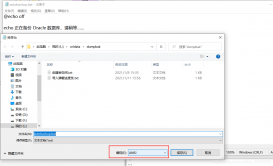1.情景展示
一共有22w条数据, 需要将a表的主键更新至b表的指定字段,如何快速完成更新?
2.解决方案
声明:
解决方案不只一种,该文章只介绍快速游标法及代码实现;
两张表的id和id_card字段都建立了索引。
方式一:使用隐式游标(更新一次提交1次)
|
1
2
3
4
5
6
7
8
9
10
11
12
13
14
|
--快速游标法begin for temp_cursor in (select t2.id, t2.id_card from virtual_card10 t1, primary_index10 t2 where t1.id_card = t2.id_card and t1.remark = '**市****区数据' and t2.remark = '**市****区数据') loop /* loop循环的是temp_cursor(逐条读取temp_cursor) */ update virtual_card10 set index_id = temp_cursor.id where id_card = temp_cursor.id_card; commit; --提交 end loop;end; |
执行时间:

方式二:使用隐式游标(更新1000次提交1次)(推荐使用)
|
1
2
3
4
5
6
7
8
9
10
11
12
13
14
15
16
17
18
19
20
21
22
23
24
|
/* 使用隐式游标进行分批次更新 */declare v_count number(10);begin /* 隐式游标 */ for temp_cursor in (select t2.id, t2.id_card from virtual_card10 t1, primary_index10 t2 where t1.id_card = t2.id_card and t1.remark = '**市****区数据' and t2.remark = '**市****区数据') loop /* 业务逻辑 */ update virtual_card10 set index_id = temp_cursor.id where id_card = temp_cursor.id_card; /* 更新一次,+1 */ v_count := v_count + 1; /* 1000条提交1次 */ if v_count >= 1000 then commit; --提交 v_count := 0; --重置 end if; end loop; commit; -- 提交所有数据,把这个去掉,可以查看是否是自己想要的效果,再决定是否提交end; |
执行时间:

方式三:显式游标+分批次更新(1000条1提交)
|
1
2
3
4
5
6
7
8
9
10
11
12
13
14
15
16
17
18
19
20
21
22
23
24
25
26
27
28
29
30
31
32
33
34
|
/* 使用游标进行分批次更新 */declare v_count number(10); v_index_id primary_index10.id%type; v_id_card primary_index10.id_card%type; cursor temp_cursor is select t2.id, t2.id_card from virtual_card10 t1, primary_index10 t2 where t1.id_card = t2.id_card and t1.remark = '**市****区数据' and t2.remark = '**市****区数据';begin open temp_cursor; loop /* 取得一行游标数据并放到对应变量中 */ fetch temp_cursor into v_index_id, v_id_card; /* 如果没有数据则退出 */ exit when temp_cursor%notfound; /* 业务逻辑 */ update virtual_card10 set index_id = v_index_id where id_card = v_id_card; /* 更新一次,+1 */ v_count := v_count + 1; /* 1000条提交1次 */ if v_count >= 1000 then commit; --提交 v_count := 0; --重置 end if; end loop; commit; -- 提交所有数据,把这个去掉,可以查看是否是自己想要的效果,再决定是否提交 close temp_cursor;end; |
执行时间:

10000条1提交,执行时间:

方式四:显式游标+数组(更新一次提交一次)(使用bulk collect)
|
1
2
3
4
5
6
7
8
9
10
11
12
13
14
15
16
17
18
19
20
21
22
23
24
25
26
27
28
29
30
31
32
33
34
|
/* 使用游标+数组进行更新(更新一次提交一次) */declare /* 创建数组:一列多行 */ type type_index_id is table of primary_index10.id%type; type type_id_card is table of primary_index10.id_card%type; /* 起别名 */ v_index_id type_index_id; v_id_card type_id_card; /* 将查询出来的数据放到游标里 */ cursor temp_cursor is select t2.id, t2.id_card from virtual_card10 t1, primary_index10 t2 where t1.id_card = t2.id_card and t1.remark = '**市****区数据' and t2.remark = '**市****区数据';begin open temp_cursor; loop /* 取得1000行游标数据并放到对应数组中,每次读取1000条数据 */ fetch temp_cursor bulk collect into v_index_id, v_id_card limit 1000; /* 如果没有数据则退出 */ exit when temp_cursor%notfound; /* 遍历数据 */ for i in v_index_id.first .. v_index_id.last loop /* 业务逻辑 */ update virtual_card10 set index_id = v_index_id(i) where id_card = v_id_card(i); commit; end loop; end loop; close temp_cursor;end; |
执行时间:

方式五: 显式游标+数组(1000条提交一次)(使用bulk collect)
|
1
2
3
4
5
6
7
8
9
10
11
12
13
14
15
16
17
18
19
20
21
22
23
24
25
26
27
28
29
30
31
32
33
34
35
36
|
/* 使用游标+数组进行更新(1000条提交一次) */declare /* 创建数组:一列多行 */ type type_index_id is table of primary_index10.id%type; type type_id_card is table of primary_index10.id_card%type; /* 起别名 */ v_index_id type_index_id; v_id_card type_id_card; /* 将查询出来的数据放到游标里 */ cursor temp_cursor is select t2.id, t2.id_card from virtual_card10 t1, primary_index10 t2 where t1.id_card = t2.id_card and t1.remark = '**市****区数据' and t2.remark = '**市****区数据';begin open temp_cursor; loop /* 取得1000行游标数据并放到对应数组中 */ fetch temp_cursor bulk collect into v_index_id, v_id_card limit 1000; /* 如果没有数据则退出 */ exit when temp_cursor%notfound; /* 遍历数据 */ for i in v_index_id.first .. v_index_id.last loop --或者:for i in 1 .. v_index_id.count loop /* 业务逻辑 */ update virtual_card10 set index_id = v_index_id(i) where id_card = v_id_card(i); if i >= v_index_id.last then commit; --提交 end if; end loop; end loop; close temp_cursor;end; |
执行时间:

方式六:推荐使用(使用bulk collect和forall)
|
1
2
3
4
5
6
7
8
9
10
11
12
13
14
15
16
17
18
19
20
21
22
23
24
25
26
27
28
29
30
31
32
33
|
/* 使用游标+数组进行更新(bulk collect和forall) */declare /* 创建数组:一列多行 */ type type_index_id is table of primary_index10.id%type; type type_id_card is table of primary_index10.id_card%type; /* 起别名 */ v_index_id type_index_id; v_id_card type_id_card; /* 将查询出来的数据放到游标里 */ cursor temp_cursor is select t2.id, t2.id_card from virtual_card10 t1, primary_index10 t2 where t1.id_card = t2.id_card and t1.remark = '**市****区数据' and t2.remark = '**市****区数据';begin open temp_cursor; loop /* 取得1000行游标数据并放到对应数组中 */ fetch temp_cursor bulk collect into v_index_id, v_id_card limit 1000; /* 如果没有数据则退出 */ exit when temp_cursor%notfound; /* 遍历数据 */ forall i in 1 .. v_index_id.count-- 或者v_index_id.first .. v_index_id.last /* 业务逻辑 */ update virtual_card10 set index_id = v_index_id(i) where id_card = v_id_card(i); commit; --提交 end loop; close temp_cursor;end; |
执行时间:

从oracle8开始,oracle为pl/sql引入了两个新的数据操纵语言(dml)语句:bulk collect和forall。
这两个语句在pl/sql内部进行一种数组处理;bulk collect提供对数据的高速检索,forall可大大改进insert、update和delete操作的性能。
oracle数据库使用这些语句大大减少了pl/sql与sql语句执行引擎的环境切换次数,从而使其性能有了显著提高。
小结:
数据量小的时候可以用方式二,数据量大的时候推荐使用方式六;
一定要建索引。
以上就是oracle使用游标进行分批次更新的6种方式及速度比对的详细内容,更多关于oracle 游标的资料请关注服务器之家其它相关文章!
原文链接:https://www.cnblogs.com/Marydon20170307/p/10097243.html












